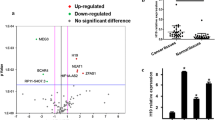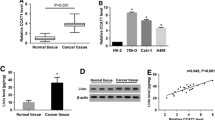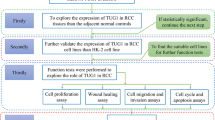Summary
This study aimed to examine the effect of long non-coding RNA (LncRNA) MEG3 on the biological behaviors of renal cell carcinoma (RCC) cells 786-0 and the possible mechanism. MEG3 expression levels were detected by RT-qPCR in tumor tissues and adjacent non-tumor tissues from 29 RCC patients and in RCC lines 786-0 and SN12 and human embryonic kidney cell line 293T. Plasmids GV144-MEG3 (MEG3 overexpression plasmid) and GV144 (control plasmid) were stably transfected into 786-0 cells by using lipofectamine 2000. Cell viabilities were determined by MTT, cell apoptosis rates by flow cytometry following PE Annexin V and 7AAD staining, apoptosis-related protein expressions by Western blotting, and Bcl-2 mRNA by RT-qPCR in the transfected cells. The results showed that MEG3 was evidently downregulated in RCC tissues (P<0.05) and RCC cell lines (P<0.05). The viabilities of 786-0 cells were decreased significantly after transfection with GV144-MEG3 for over 24 h (P<0.05). Consistently, the apoptosis rate was significantly increased in 786-0 cells transfected with GV144-MEG3 for 48 h (P<0.05). Furthermore, overexpression of MEG3 could reduce the expression of Bcl-2 and procaspase-9 proteins, enhance the expression of cleaved caspase-9 protein, and promote the release of cytochrome c protein to cytoplasm (P<0.05). Additionally, Bcl-2 mRNA level was declined by MEG3 overexpression (P<0.05). It was concluded that MEG3 induces the apoptosis of RCC cells possibly by activating the mitochondrial pathway.
Similar content being viewed by others
References
Reeves DJ, Liu CY. Treatment of metastatic renal cell carcinoma. Cancer Chemother Pharmacol, 2009,64(1):11–25
Chen X, Ruan A, Wang X, et al. miR-129-3p, as a diagnostic and prognostic biomarker for renal cell carcinoma, attenuates cell migration and invasion via downregulating multiple metastasis-related genes. J Cancer Res Clin Oncol, 2014,140(8):1295–1304
Hock LM, Lynch J, Balaji KC. Increasing incidence of all stages of kidney cancer in the last 2 decades in the United States: an analysis of surveillance, epidemiology and end results program data. J Urol, 2002,167(1):57–60
Cho IC, Chung J. Current status of targeted therapy for advanced renal cell carcinoma. Korean J Urol, 2012,53(4):217–228
van Bakel H, Hughes TR. Establishing legitimacy and function in the new transcriptome. Brief Funct Genomic Proteomic, 2009,8(6):424–436
McPherson R, Pertsemlidis A, Kavaslar N, et al. A common allele on chromosome 9 associated with coronary heart disease. Science, 2007,316(5830):1488–1491
Okamoto J, Hirata T, Chen Z, et al. EMX2 is epigenetically silenced and suppresses growth in human lung cancer. Oncogene, 2010,29(44):5969–5975
Scheuermann JC, Boyer LA. Getting to the heart of the matter: long non-coding RNAs in cardiac development and disease. Embo J, 2013,32(13):1805–1816
Gibb EA, Brown CJ, Lam WL. The functional role of long non-coding RNA in human carcinomas. Mol Cancer, 2011,10:38
Yang QQ, Deng YF. Long non-coding RNAs as novel biomarkers and therapeutic targets in head and neck cancers. Int J Clin Exp Pathol, 2014,7(4):1286–1292
Fang XY, Pan HF, Leng RX, et al. Long noncoding RNAs: novel insights into gastric cancer. Cancer Lett, 2015,356(2):357–366
Ronnau CG, Verhaegh GW, Luna-Velez MV, et al. Noncoding RNAs as novel biomarkers in prostate cancer. Biomed Res Int, 2014,2014:591703
Schuster-Gossler K, Bilinski P, Sado T, et al. The mouse Gtl2 gene is differentially expressed during embryonic development, encodes multiple alternatively spliced transcripts, and may act as an RNA. Dev Dyn, 1998,212(2):214–228
Miyoshi N, Wagatsuma H, Wakana S, et al. Identification of an imprinted gene, Meg3/Gtl2 and its human homologue MEG3, first mapped on mouse distal chromosome 12 and human chromosome 14q. Genes Cells, 2000,5(3):211–220
Liu J, Wan L, Lu K, et al. The long noncoding RNA MEG3 contributes to cisplatin resistance of human lung adenocarcinoma. Plos One, 2015,10(5):0114586
Wang P, Ren Z, Sun P. Overexpression of the long non-coding RNA MEG3 impairs in vitro glioma cell proliferation. J Cell Biochem, 2012,113(6):1868–1874
Lu KH, Li W, Liu XH, et al. Long non-coding RNA MEG3 inhibits NSCLC cells proliferation and induces apoptosis by affecting p53 expression. BMC Cancer, 2013,13:461
Braconi C, Kogure T, Valeri N, et al. microRNA-29 can regulate expression of the long non-coding RNA gene MEG3 in hepatocellular cancer. Oncogene, 2011,30(47):4750–4756
Debatin KM. Apoptosis pathways in cancer and cancer therapy. Cancer Immunol Immunother, 2004,53(3):153–159
Blondeau JJ, Deng M, Syring I, et al. Identification of novel long non-coding RNAs in clear cell renal cell carcinoma. Clin Epigenetics, 2015,7(1):10
Qin R, Chen Z, Ding Y, et al. Long non-coding RNA MEG3 inhibits the proliferation of cervical carcinoma cells through the induction of cell cycle arrest and apoptosis. Neoplasma, 2013,60(5):486–492
He Y, Wu YT, Huang C, et al. Inhibitory effects of long noncoding RNA MEG3 on hepatic stellate cells activation and liver fibrogenesis. Biochim Biophys Acta, 2014,1842(11):2204–2215
Zhang Y, Zou Y, Wang W, et al. Down-regulated long non-coding RNA MEG3 and its effect on promoting apoptosis and suppressing migration of trophoblast cells. J Cell Biochem, 2015,116(4):542–550
Kawakami T, Chano T, Minami K, et al. Imprinted DLK1 is a putative tumor suppressor gene and inactivated by epimutation at the region upstream of GTL2 in human renal cell carcinoma. Hum Mol Genet, 2006,15(6):821–830
Shimizu S, Narita M, Tsujimoto Y. Bcl-2 family proteins regulate the release of apoptogenic cytochrome c by the mitochondrial channel VDAC. Nature, 1999,399(6735):483–487
Gross A, McDonnell JM, Korsmeyer SJ. BCL-2 family members and the mitochondria in apoptosis. Genes Dev, 1999,13(15):1899–1911
Martinou JC, Youle RJ. Mitochondria in apoptosis: Bcl-2 family members and mitochondrial dynamics. Dev Cell, 2011,21(1):92–101
Budhram-Mahadeo V, Morris PJ, Smith MD, et al. p53 suppresses the activation of the Bcl-2 promoter by the Brn-3a POU family transcription factor. J Biol Chem, 1999,274(21):15237–15244
Author information
Authors and Affiliations
Corresponding author
Additional information
Both authors contributed equally to this work.
This project was supported by grants from the National Natural Science Foundation of China (Nos. 81001132, 81172423, and 81272816).
Rights and permissions
About this article
Cite this article
Wang, M., Huang, T., Luo, G. et al. Long non-coding RNA MEG3 induces renal cell carcinoma cells apoptosis by activating the mitochondrial pathway. J. Huazhong Univ. Sci. Technol. [Med. Sci.] 35, 541–545 (2015). https://doi.org/10.1007/s11596-015-1467-5
Received:
Revised:
Published:
Issue Date:
DOI: https://doi.org/10.1007/s11596-015-1467-5




